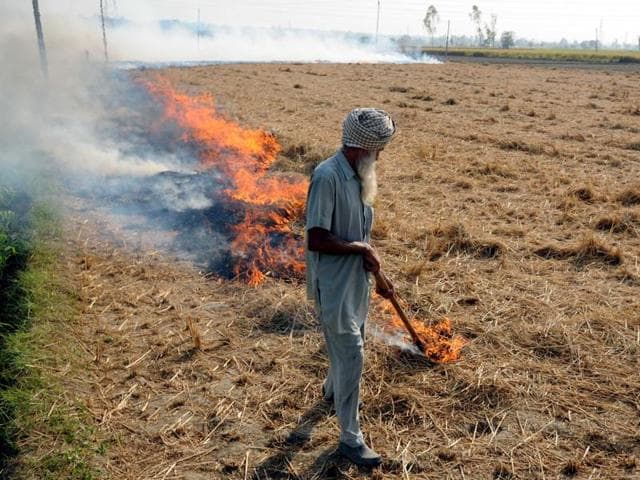Stubble burning: Growing mechanisation, increase in paddy area added to problem
Sukhwant Singh, a farmer in Haryana’s Kurukshetra, had most of his 12 acres of agricultural land under paddy. After harvesting his crop, he set the paddy stubble on fire, burning it to the ground within a few hours.
Sukhwant Singh, a farmer in Haryana’s Kurukshetra, had most of his 12 acres of agricultural land under paddy. After harvesting his crop, he set the paddy stubble on fire, burning it to the ground within a few hours.

Singh and most other paddy growers in Punjab and Haryana, who are facing financial constraints due to falling productivity and dwindling returns, do not care about the ban on stubble burning put in place by the state governments in 2003-04.
District authorities issue notices and impose financial penalties to those who overlook the ban. In the current season, Haryana has issued notices to 1,472 offenders for a total penalty of Rs 15 lakh till Monday. Punjab issued notices to 736 farmers till October 27 but stopped since then.
The ban, however, was never seriously implemented as farmers are a huge political constituency.
The result: the stubble burning has increased in recent years. Officials with regional pollution control board say stubble burning in neighbouring states of Haryana and Punjab is one of the major contributing factors to the severe smog in Delhi and the national capital region.
Delhi is witnessing worst smog in 17 years, which has pushed pollution, is making children wheeze, giving the otherwise healthy a chronic cough, and risking 17 million people to asthma, heart disease, stroke, and even cancer.
The city of 20 million people, which ranks among the world’s top cities with foul air on a World Health Organization list, has been struggling to clean its air that contains a toxic cocktail of dust, smoke and gases from vehicle, factory exhausts and coal-fired power stations.
Besides the cost factor, growing mechanisation of paddy harvest, non-availability of stubble management equipment and an increase in area under paddy cultivation have contributed to stubble burning. Between 2006 and 2016, paddy area in Punjab has increased by 20%, going up from 25 lakh hectares to 30 lakh hectares.
“Due to mechanisation of paddy harvest, the crop residue that remains in the field is of larger quantity and when burnt causes larger smoke quantity,” a Punjab State Farmers Commission consultant said.
As per the commission, the cost of removing stubble comes to roughly Rs 1,000 per acre.
Haryana Kisan Ayog secretary RS Dalal said the burning of crop residue is the least expensive option available to farmers.
“The straw management equipment is costly and the process time consuming. Also, the cost of stubble management is not taken into account while determining the minimum support price (MSP). We want the farmers to spend money so that we get a clean environment,” Dalal told Hindustan Times.
He said the stubble problem was not as severe when paddy was harvested manually because the farmers use to cut it as close to the ground as possible.
Another agriculture expert said that farmers burn their paddy stubble because they do have much time available between two crops.
“Wheat sowing has to be completed by November-end. Delay in sowing means a decline in yield. This leaves them with very little time to clear the farm for sowing. Crop residue burning affects soil health, but they do ignore it,” he said.
Last week, the National Green Tribunal (NGT) pulled up the states of Haryana, Rajasthan and Uttar Pradesh for not stopping the large-scale burning of crop stubble that has sent air pollution Delhi-NCR to a critical level.
The NGT directed the three states to comply with its earlier order of taking coercive and punitive action against those who burn agricultural waste and directed them to file affidavits detailing steps taken for the implementation of its order.
Get Current Updates on India News, Lok Sabha election 2024 live, Election 2024 along with Latest News and Top Headlines from India and around the world.



